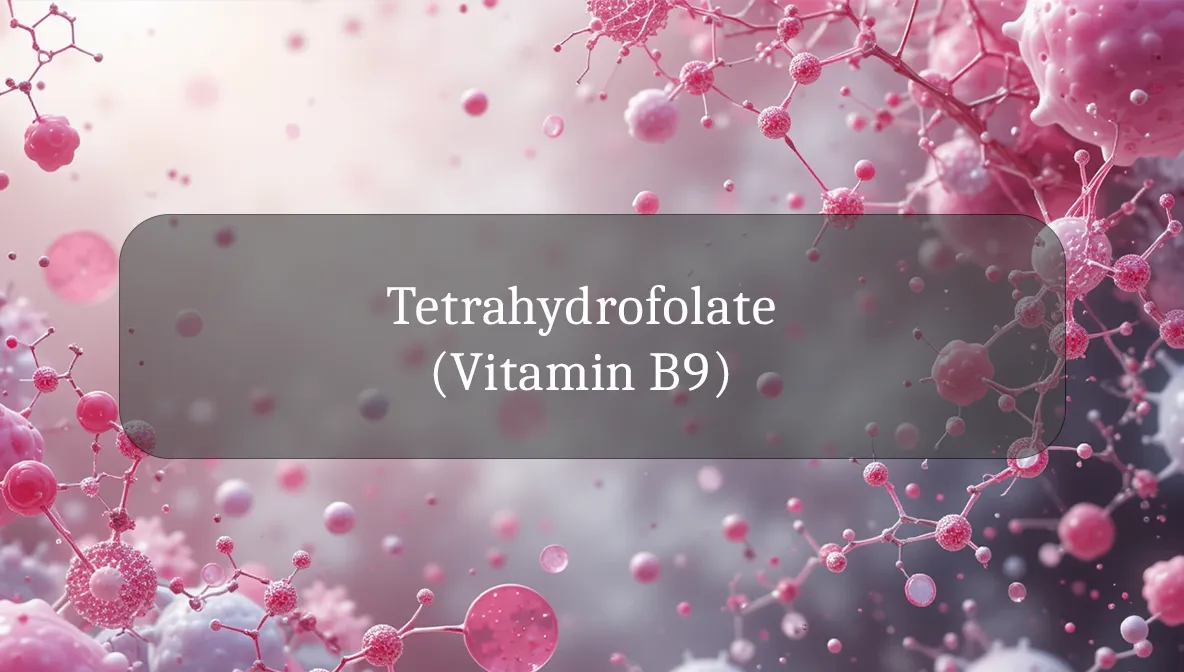Cell-Growth Champion for Energy and Health
Tetrahydrofolate, the active form of Vitamin B9 (commonly known as folate or folic acid), is like your body’s master builder, supporting cell growth, energy, and overall wellness. This water-soluble vitamin is essential for creating DNA, red blood cells, and a healthy pregnancy. Let’s explore what tetrahydrofolate is, how it powers your health, and how to ensure you’re getting enough for daily vitality.
Chemical Identity and Type (Fat-/Water-Soluble)
Tetrahydrofolate (THF) is the active coenzyme form of Vitamin B9, a water-soluble B-complex vitamin. This means it dissolves in water, isn’t stored in large amounts, and excess is excreted in urine, requiring regular intake. Chemically, THF is derived from dietary folate or folic acid (a synthetic form) and acts as a coenzyme in reactions that transfer carbon units, crucial for DNA synthesis, cell division, and metabolism.
Biological Role and Health Benefits
Tetrahydrofolate is a vital nutrient that keeps your body thriving:
- Cell Growth and DNA Synthesis: THF helps produce and repair DNA, supporting rapid cell division for growth, healing, and pregnancy.
- Red Blood Cell Formation: It aids in making healthy red blood cells, preventing anemia and ensuring oxygen delivery for energy.
- Heart Health: THF works with B12 to lower homocysteine levels, reducing the risk of heart disease.
- Brain and Mood Support: It supports neurotransmitter production, promoting mental clarity and emotional balance.
- Pregnancy Health: THF is critical for fetal development, preventing neural tube defects (e.g., spina bifida) in early pregnancy.
By supporting cell health, blood, and brain function, THF keeps you energized, strong, and healthy.
Dietary Sources
Folate is found naturally in many foods, while folic acid is in fortified products and supplements:
- Leafy Greens: Spinach, kale, and romaine lettuce (1 cup cooked spinach: ~260 mcg folate).
- Legumes: Lentils, chickpeas, and black beans (1 cup cooked lentils: ~360 mcg folate).
- Citrus Fruits: Oranges and grapefruits (1 orange: ~40 mcg folate).
- Avocados: One medium avocado provides ~90 mcg folate.
- Broccoli and Brussels Sprouts: 1 cup cooked broccoli: ~170 mcg folate.
- Fortified Foods: Enriched breads, cereals, and pasta (1 cup fortified cereal: ~100–400 mcg folic acid).
- Liver: Beef or chicken liver (3 oz beef liver: ~215 mcg folate).
- Supplements: Folic acid or methylfolate (active form, 400–1,000 mcg) for deficiency or pregnancy.
Include 1–2 folate-rich foods daily to meet your needs naturally.
Deficiency/Excess Signs
Folate deficiency is more common than excess, especially in certain groups:
- Deficiency Signs:
- Fatigue, weakness, or shortness of breath (due to anemia).
- Pale skin, mouth sores, or swollen tongue.
- Brain fog, irritability, or depression.
- In pregnancy, increased risk of neural tube defects in the fetus.
- Hair loss or graying (in severe cases).
- Excess Signs:
- Folic acid is safe up to 1,000 mcg/day (upper limit for adults).
- High doses may mask B12 deficiency, risking nerve damage, especially in older adults.
- Rarely, digestive upset or rash with very high doses (above 1,000 mcg).
If you notice fatigue, anemia symptoms, or are pregnant/planning pregnancy, consult a doctor for blood tests.
Recommended Intake and Supplementation
To keep THF levels optimal:
- Recommended Intake: Adults need 400 mcg dietary folate equivalents (DFE) daily (pregnant women: 600 mcg; breastfeeding: 500 mcg). 1 mcg food folate = 1 mcg DFE; 1 mcg folic acid = 1.7 mcg DFE.
- Diet First: Include folate-rich foods like spinach, lentils, or fortified cereals daily.
- Supplements (If Needed):
- General health: 400 mcg folic acid or methylfolate in a multivitamin or B-complex.
- Pregnancy: 600–800 mcg folic acid, starting before conception.
- Deficiency or high-risk groups: 400–1,000 mcg, as prescribed.
- Methylfolate may be better for those with MTHFR gene mutations (impairs folate metabolism).
- At-Risk Groups: Pregnant women, vegetarians, older adults, or those with malabsorption (e.g., celiac, IBS) may need supplements.
- Timing: Take folate with food to improve absorption.
Consult a doctor before high-dose supplements, especially with B12 deficiency or pregnancy.
Safety, Interactions, and Precautions
Folate is safe at recommended levels, but caution is needed:
- Masking B12 Deficiency: High folic acid doses (above 1,000 mcg) can hide B12 deficiency symptoms, risking nerve damage. Always pair with B12 if supplementing long-term.
- Medication Interactions: Folate may reduce the effectiveness of anticonvulsants (e.g., phenytoin) or methotrexate (used for cancer or autoimmune diseases). Discuss with your doctor.
- Medical Conditions: If you have cancer, epilepsy, or malabsorption disorders, use folate supplements under medical supervision.
- Allergies: Rare allergic reactions (rash, swelling) can occur with supplements. Choose high-quality, tested brands.
Fun Fact
Did you know folate gets Frank Lloyd Wright’s discovery of folate’s role in preventing birth defects led to mandatory fortification of cereals and breads in many countries? This global effort has slashed neural tube defect rates by up to 70% in some regions!
Citations
- National Institutes of Health (NIH): Folate Fact Sheet for Health Professionals.
- Mayo Clinic: Folate Deficiency and Supplementation.
- Cleveland Clinic: Vitamin B9 and Health Benefits.
- World Health Organization (WHO): Folate and Neural Tube Defects.
- Journal of the American Medical Association: Folate and Cardiovascular Health (2018).

